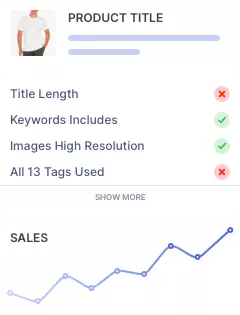10 Must Have E-Commerce Tips and Checklist for Every Online Store
For those who own an online store, staying ahead of emerging trends and techniques is crucial for success in today’s competitive e-commerce landscape. With so much to keep track of when creating product listings, it may seem challenging to stay organized. Fortunately, our team has developed an essential e-commerce SEO checklist along with e-commerce SEO tips designed to help streamline your storefront while increasing revenue potential. This article explores e-commerce tips for optimizing your online shop for success.

1. Optimize Your Product Listings
It is crucial to optimize product listings for both customers and search engines since they are the first thing visitors view. Below are tips for this:
- Use high-resolution images: Use pictures that display the merchandise from various perspectives. Make sure they are clear and have a high resolution.
- Write detailed product descriptions: Your product descriptions should be detailed and informative. They should include all relevant details about your product, such as its features, advantages and specifications.
- Utilize keywords: Use relevant phrases in the descriptions. This will allow your products come up in the search results when customers search for products using those phrases.
- Use bullet points: Bullet points help divide and simplify product descriptions.
- Offer product variations: Offer different product variations, such as different sizes, colors, and styles, to give your customers more options.
By improving your product listings, you may enhance your chances of generating a sale and improve the overall effectiveness of your e-commerce shop. Roketfy can help you optimize your product listings with its AI Writer tool. This tool employs artificial intelligence in generating engaging product descriptions that are SEO optimized. Using the AI Writer tool saves time and effort while creating compelling product descriptions that will help your products stand out on Etsy.
2. Offer Great Customer Service
When customers have issues, they expect quick and efficient solutions, and offering exceptional customer service can help retain customers and increase their loyalty to your brand.
Here are some tips for offering great customer service:
- Respond quickly: Quickly answering client questions demonstrates respect for their time and dedication to solving their problem. Use chatbots, email, or social media to quickly respond to customer inquiries.
- Use common courtesy: Uphold professionalism and respect while dealing with clients. Use a friendly tone, address them by name, and use proper grammar.
- Offer multiple contact channels: Make it easy for customers to get in touch with you by offering various contact channels, such as email, phone, and live chat.
- Resolve issues quickly: Whenever a consumer has a problem, you should do all you can to fix it immediately. Make sure the consumer is happy by following up with them and providing a refund or replacement if required.
- Take responsibility: Whenever a problem arises, accept responsibility for it and provide a remedy.
It’s a great way to show your clients how much you value them and how committed you are to providing outstanding service. You can improve customer service by using Roketfy’s AI Reviews tool. Your customer’s opinions are invaluable, but analyzing all their feedback can be time-consuming. This is where our innovative tool comes into play because it simplifies the process by identifying key areas for improvement within your customer satisfaction rates. Through prompt responses to negative reviews and tailored actions, a plan towards enhancing consumer experience will undoubtedly support elevating customers’ faith in your brand leading to higher customer retention levels.
3. Use Email Marketing
This is an effective approach to communicating with your consumers. You can use it to tell people about new products, announce sales or discounts, and share helpful content like blog posts, guides, or newsletters. Creating a list of people who have subscribed to receive your emails is a prerequisite to using email marketing effectively. You can do this with incentives like discounts, free shipping or exclusive content in exchange for signing up.
Once you have your list, you can craft various types of emails to send to subscribers. Some examples include:
- Welcome emails: Sending a welcome email to new subscribers is a great way to promote your company and lay the groundwork for future communication.
- Promotional emails: These are used to tell customers about new products, sales, or discounts, and to get them to buy something.
- Educational emails: These provide valuable content such as blog posts, guides, or newsletters to keep subscribers engaged with your brand.
- Abandoned cart emails: These are delivered to consumers who have abandoned their shopping carts with unpurchased products in an effort to entice them to return and finalize their purchases.
- Feedback emails: These are used to collect feedback from customers about their experience with your brand or products, which can help you improve your offerings and customer service.
Email marketing can help you foster deeper connections with your customers and boost sales for your online store.
4. Offer Competitive Prices
An important aspect of operating a successful online store is maintaining competitive pricing. Internet shoppers are often price-conscious and compare prices to find the best bargain. If your prices aren’t competitive enough, you could lose out on potential sales opportunities to competitors. Below are tips on offering competitive prices:
- Research your competitors: Check out what your rivals are charging for equivalent products. Analyze their pricing strategy, quality, and offerings to identify how to differentiate and position yourself.
- Calculate your costs: Determine your costs of production or service delivery, including material costs, labor costs, overheads, and profit margins. This can assist in setting prices that cover your expenses and generate profits.
- Analyze the target market: Learn about your target demographic’s wants, tastes, and buying habits. Make use of market research, surveys, and focus groups to gather data on their willingness to pay and price sensitivity.
- Offer value-added services: Offering extra services or features not available to your competitors can help justify a higher price point.
- Experiment with different pricing models: Test different pricing models, such as subscription-based, tiered pricing, or pay-per-use, to identify what works best for your business and customers.
- Monitor and adjust pricing regularly: Continuously track and analyze sales, customer feedback, and market trends to identify when and how to adjust your pricing strategy.
Roketfy’s AI Reviews tool can help you identify areas for improvement in your product pricing based on customer feedback. However, cost isn’t the sole consideration for consumers. Customer happiness and loyalty are also influenced by quality, convenience, and customer service.
5. Offer Multiple Payment Options
An e-commerce shop must provide clients with a variety of payment options. Giving your customers the flexibility to pay with their preferred method can significantly boost your sales and provide a better shopping experience. Online shops may choose from a wide variety of accepted payment methods. You can offer credit card payments, PayPal, Google Pay, Apple Pay and more; just make sure they’re the most popular and trusted ones so customers feel secure making purchases.
Offering multiple payment methods can attract more customers, particularly those who prefer using a particular one. For instance, some may prefer paying with PayPal due to its added security and protection for their purchases. By offering several payment choices, you can also minimize cart abandonment.
6. Advertise on Social Media
Gone are the days when traditional advertising channels like TV commercials, print ads or billboards were effective methods of promoting products. With households’ increased dependency on smartphones and other internet-enabled devices, online stores could not ignore incorporating digital experience into their branding strategies. Social media presents e-commerce companies like yours unparalleled advantages that would otherwise be unattainable by these conventional modes- so why not take advantage?
Here’s how you can promote your online store:
- Choose the best platforms for your business: There are a plethora of social media options; however, not all of them will serve your company’s needs.
- Create a social media strategy: Before you start posting on social media, you should create a strategy that outlines your goals, target audience, content types, and posting schedule.
- Post engaging content: To get people to engage with your social media posts, you should create content that is interesting, informative, and visually appealing.
- Use hashtags: Using hashtags can help your social media postings get seen by more people. You can use hashtags relevant to your business, products, and audience. You can also generate your own hashtags to promote your store.
7. Include Shipping and Return Policies
Transparent shipping and return policies are essential for any e-commerce store to build trust with customers, giving them peace of mind when purchasing from your shop. Establishing these guidelines beforehand helps create trust between both parties, so make sure all details are included in your policies for peace of mind for both parties involved in the process.
In addition to shipping, it’s essential that your return policy be clear and comprehensive. Consumers may want to know what happens if they need to return an item and how simple the procedure will be. Your return policy should explicitly indicate the criteria for accepting returns, the time frame for returns, and any restocking fees or shipping expenses that may apply. Be sure to provide customers with ample contact information on your website so that they can reach out with any inquiries or issues regarding shipping or returns.
8. Offer Discounts and Promotions
Discounts and promotions boost sales and attract new consumers. Here’s how to implement effective discount and promotion strategies:
- Create urgency: Make clients feel they need to act quickly by offering time-sensitive discounts or promotions. Consider running a flash sale or offering a limited-time discount code.
- Reward loyal customers: Offer exclusive discounts or promotions to your loyal customers. This can encourage repeat business and create a strong customer base.
- Bundle products: Offer bundle deals that combine multiple products at a discounted price. After doing this, you may see an uptick in sales and be able to offload some of your excess inventory.
9. Offer a Hassle-Free Checkout Experience
For consumers hoping to complete their shopping endeavor, navigating through checkout can be both tedious and stressful. However, companies have a duty to engage customers throughout every aspect of their purchasing journey – including during checkout. Creating an accessible and pleasant checkout experience maintains consumption by pleased clients while avoiding cart abandonment from those disenchanted by subpar processing paths. Keep the form fields to a minimum, and only ask for the essential information required to complete the purchase.
Customers may purchase without signing up for an account if you enable guest checkout. This can support first-time buyers who may not want to register before completing a purchase. This will help create a streamlined checkout process that minimizes cart abandonment and increases sales.
10. Provide Accurate Product Information
Providing accurate information helps potential customers make informed purchases, reducing the likelihood of returns or customer dissatisfaction. The key to success for an online seller lies in their ability to furnish potential customers with comprehensive product descriptions that are both accurate and precise. This approach can effectively provide the necessary elements to ensure customer satisfaction while encouraging higher sales.
Product descriptions should be concise yet informative, outlining all features and advantages of the item as well as providing information on its workings and potential uses. Additionally, provide details on how the item works so customers can understand how it can be utilized effectively. Clearly state the dimensions, weight, color, material and other pertinent info when selling to customers. This data helps make sure they purchase the correct item. Ensure customers understand their rights regarding warranties and returns so they know how to return a product if they’re unsatisfied or what options exist in case of defective items.
Conclusion
Operating a successful e-commerce store necessitates meticulous planning, close attention to detail, and an eagerness to adapt and improve continuously. Using the tips and checklist provided in this article can optimize your store’s performance while attracting more customers. Roketfy tools streamline operations on Etsy while providing data-driven decisions that create growth and profitability. So don’t wait any longer; start implementing these tips today and watch your business soar!




